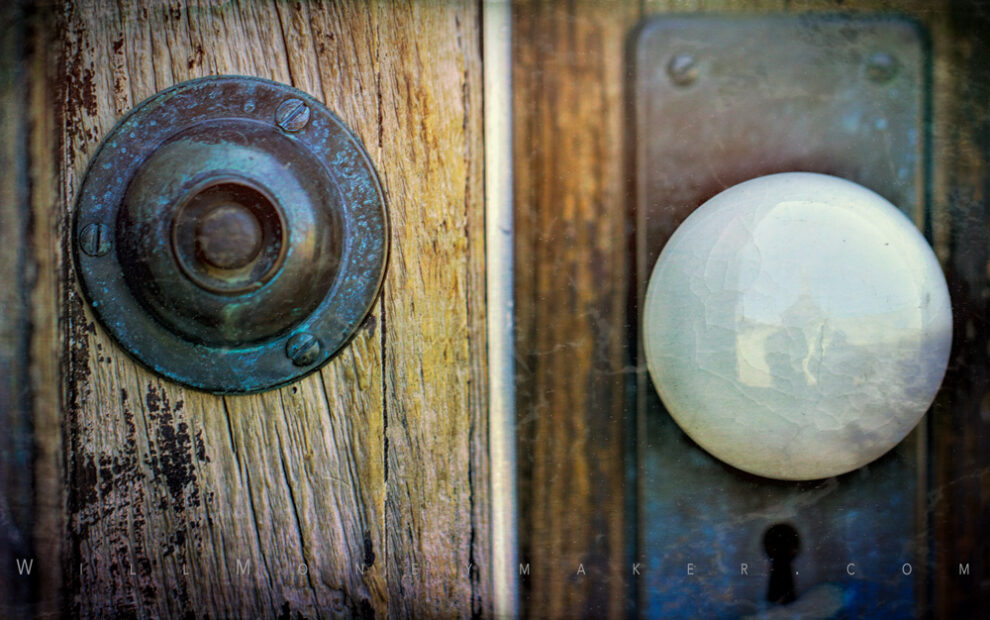Photography is all about the subject. At least, that’s what the textbooks teach us. Thus, we’re always thinking about photographs in terms of the subject itself:
- What is the subject?
- Is it interesting or beautiful in its own right?
- Can viewers relate to the subject in some way?
We search endlessly for the best ways to light our subjects, and the most flattering angles at which to portray our subjects. The point is, so much of photography revolves around the technical details of capturing the subject just right.
For beginner photographers, the concept is sound. Photography should be all about the subject. However, once you start advancing as not just a photographer, but an artist, I think an important realization must be made. The magic of a photograph comes not only from the subject but from the relationships the subject has with other things in the photograph.
Consider, for example, a photograph of a door. On their own, doors just aren’t that special. We all have them in our homes, our workplaces. Some of us probably walk through dozens of doors of varying types each and every day. Doors are commonplace, and as such, not that interesting.
So if you create a photograph of a door, what is it about the photograph that is interesting? Is it the door itself? Maybe the wood is old, weathered and splintered. Again, this is something that, on its own, is relatively common — lots of doors are weathered. But, perhaps that battered old door features prominently on a new, freshly painted wall. Now you have a relationship, and an odd one, at that. The viewer is left to wonder why this old, battered door remains on an otherwise pristine wall.
Relationships can go farther than that, too. Perhaps the door is ajar, and beyond, you can catch a glimpse of a beautiful garden. Here is another relationship for the viewer to ponder. Why should an old, battered door on a pristine wall lead to a garden full of flowers and foliage?
Now that you are starting to see how relationships with other elements in the frame affect the subject material, the next question to answer is one of how many relationships should be visible within the frame. For this question, there is no firm number. Every subject is different. However, three relationships make a good starting point. It’s enough that the photographer has plenty of elements to build interest in the scene, and it’s enough that the viewer has plenty to ponder without being overloaded. If desired, you can build from there, just so long as you are careful not to make the photograph too busy.
I’ve established that relationships are important in making a photograph’s subject material interesting, but there’s more yet to learn about the different types of relationships that can be present within an image. Let’s take a look at some of the most common types of relationships that you can establish so that you can start using them to great effect in your own images.
Relationships Between the Subject and Other Elements
Relationships that can be developed between the subject and other elements in the frame are the most common — and easiest — relationships to set up. In the illustration above, you could see how the door, wall, and garden all related to each other. But that’s just one example. Unless you are taking very minimalist photographs, there are nearly always ways to show how objects play on each other. Candid photography serves as a prime example. In these images, photographers often show the subject interacting with another person or object. What the person is doing in the frame — the relationship that he or she has with the people or things in the photograph — are what makes a candid photograph interesting. Always be aware of the ways in which the elements you are capturing can interact because these are the things that you can build upon to make images engaging.
The Subject and the Environment
The environment is another key way to build up relationships. This is particularly true in outdoor photography, where you have things like sunshine, or the lack of it, the breeze bending the grass and other elements that can add a certain ambiance to the image. Consider, for example, an image of a prairie, or another landscape scene. How does the scene relate with the sky? The image of the prairie on a sunny day has a completely different feeling and meaning than an image of a prairie on a stormy day. One is happy and picturesque while the other feels foreboding and ominous. Consider these details as you put an image together because the connection between your subject material and the environment is all important when it comes to setting the mood.
How Lighting Relates to Your Subject
There are three different ways that lighting can intermingle with your subject material: Color, amount and direction. Color temperature, much like a sunny sky versus a cloudy sky, can have a huge impact on the mood of an image. Warmer colors often tend to feel happier or more serene while cool lighting comes with a more subdued effect. The amount of light works similarly. Brightly lit images can come across as cheerful, so long as the subject material supports a sense of cheerfulness, whereas dim images may be a bit more ominous. Of course, both of these statements are rules of thumb — in different situations, different types of lighting or varying quantities can add a number of surprising effects.
Finally, there is directional lighting. If you shoot with the lighting to one side or another, how long is the shadow that your subject casts? In portraiture, you can deliberately shade the face of your subject to add a sense of mystery. Backlighting can evoke feelings of summer warmth or simply provide a sharp contrast between your subject and the background. Experiment with the relationship between your subject and the lighting in order to find the lighting that best suits what you are trying to accomplish with the photograph.
There are, of course, many more connections to be made than those that I’ve listed here. However, these ideas should get you started. As you compose images, keep these things in mind and you’ll soon start to see how each piece of an image works together to create an interesting, engaging whole.





